Indigenous Americas
1/20
Earn XP
Description and Tags
lock in
Name | Mastery | Learn | Test | Matching | Spaced |
|---|
No study sessions yet.
21 Terms
Bandolier Bag. Lenape (Delaware tribe, Eastern Woodlands). c. 1850 CE. Beadwork on leather.
Form:
-Changes:
-Continuities: Spot stich technique to string beads and sew down in groups. Animal hides used, and Prairie style (Delaware region). Beads are in floral patterns (abstract/natural) that represent tribal identity
Function:
-Continuity: worn as a pouch for carrying personal items. Worn during ceremonial events/communal gatherings
Context:
-Changes: designed after the bags that European soldiers who came to America wore. Beads were acquired through trade with Europeans and silk ribbons used for the tassels (glass beads replace natural ones). Cloth traded with Europeans used. Happened after forced relocation
-Continuities: Allows natives to express group identity/social status despite relocation
Content:

Black-on-black ceramic vessel. Maria Martinez and Julian Martinez, Tewa, Puebloan, San Ildefonso Pueblo, New Mexico. c. mid-20th century CE. Blackware ceramic. ADD MORE!
Form:
-Changes: altered to appeal to nonindigenous people with the use of polish (new). New black on black style where there were areas of matte/polish created by a liquid mix of clay/water to create the matte outside.
-Continuities: Blackware ceramic and firing method of the clay: pinyon pine wood. Coiling/slip painting technique: coils of clay stacked/shaped by hand, creating a smooth surface and round shape with a narrow neck.
Function:
-Changes: created for European buyers. Function change from an artistic to economic purpose: ritual → decorative/commercial
-Continuities:
Content:
-Changes:
-Continuities: Geometric patterns and feathers symbolizing prayer/honor. Rain clouds symbolize the need/importance of rain in agriculture, birds represent freedom/connection between the Earth and sky. Mountains/rivers: importance of nature. These abstracted motifs were Pueblo ideas on balance/order created by symmetry
Context:
-Changes:
-Continuities: This kind of pottery was usually used for cooking/storage and ceremonial purposes. Martinez was indigenous
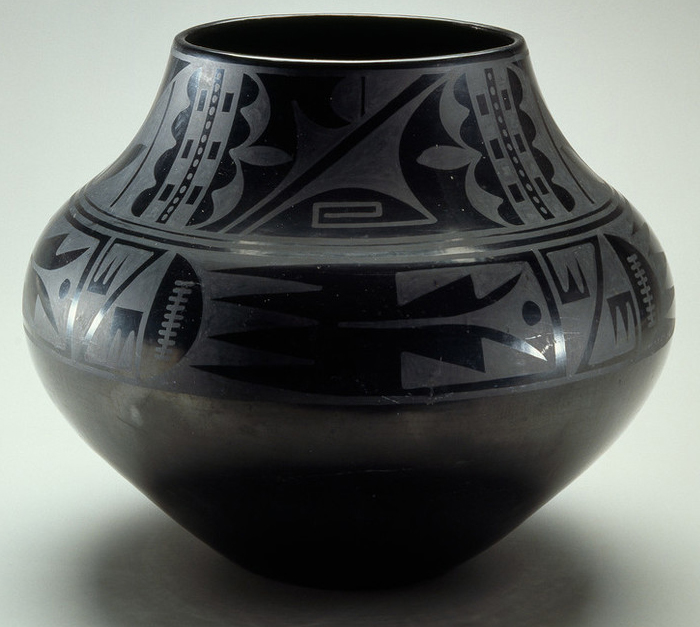
Maize cobs. Inka. c. 1440-1533 CE. Sheet metal/repousse, metal alloys.
Context: found in the religious compound Qorikancha in Cuzco (Inka capital).
-Located in the courtyard of the temple among other miniature animals/people made out of gold/silver
-Garden: represented the huge space controlled by the Inka in a compact manner and the vast ecosystems/agricultural products cultivated in the empire.
-Maize=one of the most important imperial foods → maize beer at political feasts which cemented the political obligations of Inka leaders
-Inka defeat: Spanish royalty set up colonies and take Inka objects to send back to Spain. The corn collection of King Charles V is very similar to this one. Spanish came here looking for gold/silver.
Function: asserted the natural world as an Inka possession and enforced their divine right to rule.
-Acted as an offering in rituals supporting the state religion/government. Offerings act as symbols of supernatural origin and control of the natural world as descendants of the Inka sun deity.
Content: mimics the appearance of an ear of corn breaking through its husk ready to be harvested.
-Individual kernels are nested inside, with jagged metallic leaves. Ears are life-sized and want to mimic internal/external components of real corn
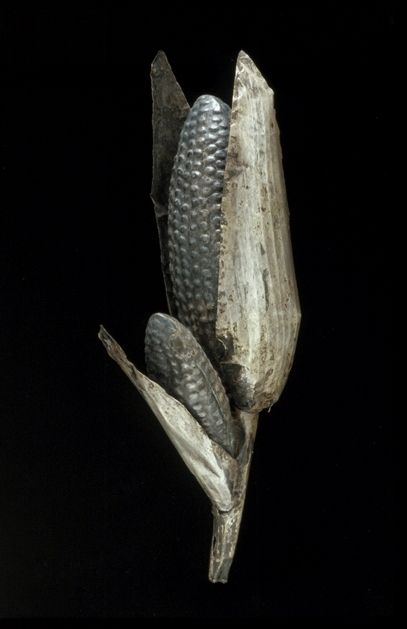
City of Machu Picchu. Central highlands, Peru. Inka. c. 1450-1540 CE. Granite (architectural complex).
Context: located at the meeting point of the Peruvian Andes and Amazon Basin. Built in the 15th century and abandoned when the Inka empire was conquered by Spaniards in the 16th century.
-From the prd of the two great Inca rulers who were centralized/authoritarian
-Society: emperor (treated like a god), followed by close relatives of the emperor/previous rulers, distant relatives, leaders of conquered peoples
Form:
-200 structures are on a steep ridge crossed stone terraces. Divided into an upper/lower part separating farming from residential and a large square between the two.
-Blends well with the natural environment with numerous subsidiary (less important but supplementary) structures, extensive roads, irrigation canals, and agricultural terraces. B/c the topography is rugged, there is a mosaic of used/natural habitats → rich diversity of flora/fauna of the Amazon Basin.
-Terraces: increased arable land surface/reduced erosion. Very important to maize.
-Stone channels drain rain water to stone fountains
-Buildings: walls made out of stones individually shaped to fit. Outward faces are smoothed to represent a mosaic and topped with a wood roof. There is a trapezoid entrance/niches/windows. (Cyclopean masonry).
-Religious structure # is high because the royal family performed rituals to sustain relationships with the supernatural forces that drove existence
-Temple of the Sun: has an upper curved stone enclosure with windows/niches. The windows were modified to signify the Summer Solstice.
-Observatory: embodied cosmological thought and facilitated astronomical observation. Pachacuti claimed to be the descendant of the sun god (Inti), so it was adjacent to the royal residence.
-Intihuatana stone: ritual area carved boulder=Inca connection with the Earth. Used to track the passage of the sun throughout the year to determine religious events.
Function: royal residence for the first Inka emperor. The emperor/his family would host feasts, perform religious ceremonies, and administer affairs of the empire here. Also has housing for elites, shrines, and signature Inca rock outcrops.
-Temporary residency. The Great Plaza was in the center, and the emperor’s residence to the SW, while high-status residential to the NE

Mesa Verde cliff dwellings. Montezuma County, Colorado. Ancestral Puebloan (Anasazi). 450-1300 CE. Sandstone.
Form: 600 structures built into cliffs (underneath/outside) of a flat top mountain in the 4 corners region of the US. Wooden beamed roofs.
-There are 150 rooms which are well protected from natural elements because of the location. 1-4 story buildings made of stone, mud mortar, and wooden beams used. (Shift from original buildings made of adobe)
-Kivas: circular rooms with wooden-beamed roofs, a fire pit, ventilation shaft, and small ceremonial hole in the floor. Families are in architectural units surrounding this. Used for ceremonies AND residential.
Function: residential/storage/ritualistic housing for 125 people. Courtyards (concaved in areas) are for communal gatherings. Dwellings were accessed with retractable ladders.
Content: murals and geometric shapes in orange, red, and brown located in the buildings
Context: built by the Puebloans. The habitat it’s located in is now a national park. Structures were carved into the cliffs in a cool climate which provided shade/protection from the snow.
-Puebloans were sedentary farmers who cultivated beans, squash, and corn
-End: droughts could have caused food shortage and conflict, causing abandonment
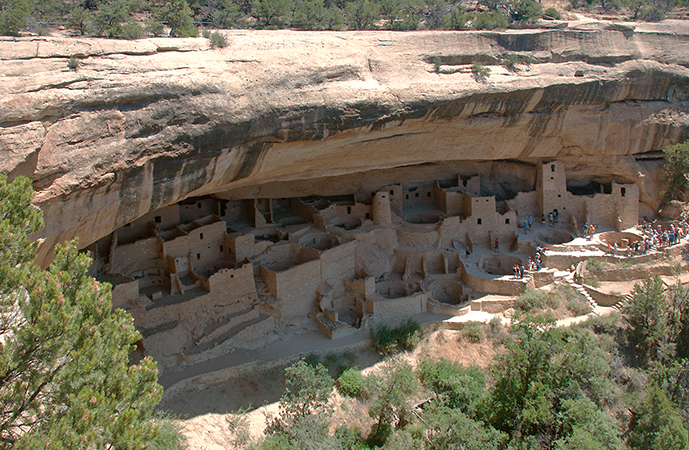
Chavin de Huantar. Northern highlands, Peru. Chavin. 900-200 BCE. Stone (architectural complex); granite (Lanzon sculpture); hammered gold alloy (jewelry). R
Lanzon stele: Channel carved at the top to put liquid in for liquid offerings. Over 15 feet tall with an image of a supernatural being: large round eyes looking up with the left hand pointing down and right hand up: heavens and earth.
- The shape of the stele is like a digging stick used in highland agriculture, indicating successful plant/harvest from the deity’s power.
-Mix of human/animal features. Jaguar/caiman (fangs/long, talon-like fingernails) which are apex predators, and eyebrows/hair like snakes.
-Animal heads on the tunic: two heads which share the same fanged mouth: contour chivalry technique.
Function of the stele: deliberately confusing, creating a barrier between believers who can see the form vs those who cannot
Ornament: passes through the septum. Serpent heads flank left/right and have upward eyes like the Lanzon.
-Function: worn by an elite to show allegiance to the Chavin religion and a status symbol.
-Form: hammering/cutting gold (metallurgy)
Building Function: temple was an important pilgrimage site bringing people/their offerings.
Building Form: located near the confluence of the Huachesca and Mosna Rivers, which are seen as a spiritually powerful phenomenon.
-U-shaped temple: the older one in 900 BCE, and the New Temple: 500 BCE, which added a rectangular sunken court
-Roughly shaped stones were used for the walls/floors and the smoother ones for carved elements. It has a maze of galleries in darkness (no windows) but air can pass through smaller tunnels, which may have projected sound to pilgrims in the plaza outside.
Great Serpent Mound. Adams County, southern Ohio. Mississippian (Eastern Woodlands). c. 1070 CE. Earthwork/effigy mound.
Context: made by settled peoples who cultivated maize, beans, etc,.. and had an organized labor force. No written records left
-many native cultures in the Middle Ohio Valley attributed supernatural powers to snakes as well as including them in spiritual practices.
-Mississippian period: growth of towns/mounds. Belief in the supernatural where there was a world above/below and an earthly center. They believed the earth was a disc that periodically faced these worlds
-Probably made by the Fort Ancient Culture. They were influenced by Mississippian culture to build the mounds (rattlesnake theme) or could have refurbished the structure
-BEFORE European conquest
Form: crescent-shaped and the head located at the east, the tail the west. It has 7 winding coils in between.
-The oval shape could be an enlarged eye, egg, or jaw. Could be the sun (solar eclipse) or mimic the Draco constellation.
-conforms to the natural topography (high plateau overlooking a creek) where the head approaches a steep natural cliff. The head aligns with the summer solstice sunset and the tail points to the winter solstice sunrise. Curves of the body could follow lunar phases or align with the two solstices/equinoxes.
-no artifacts or graves, but nearby the burials the Adena (not Fort) created
-Mound: large earthen structure with flat top
Function: unknown
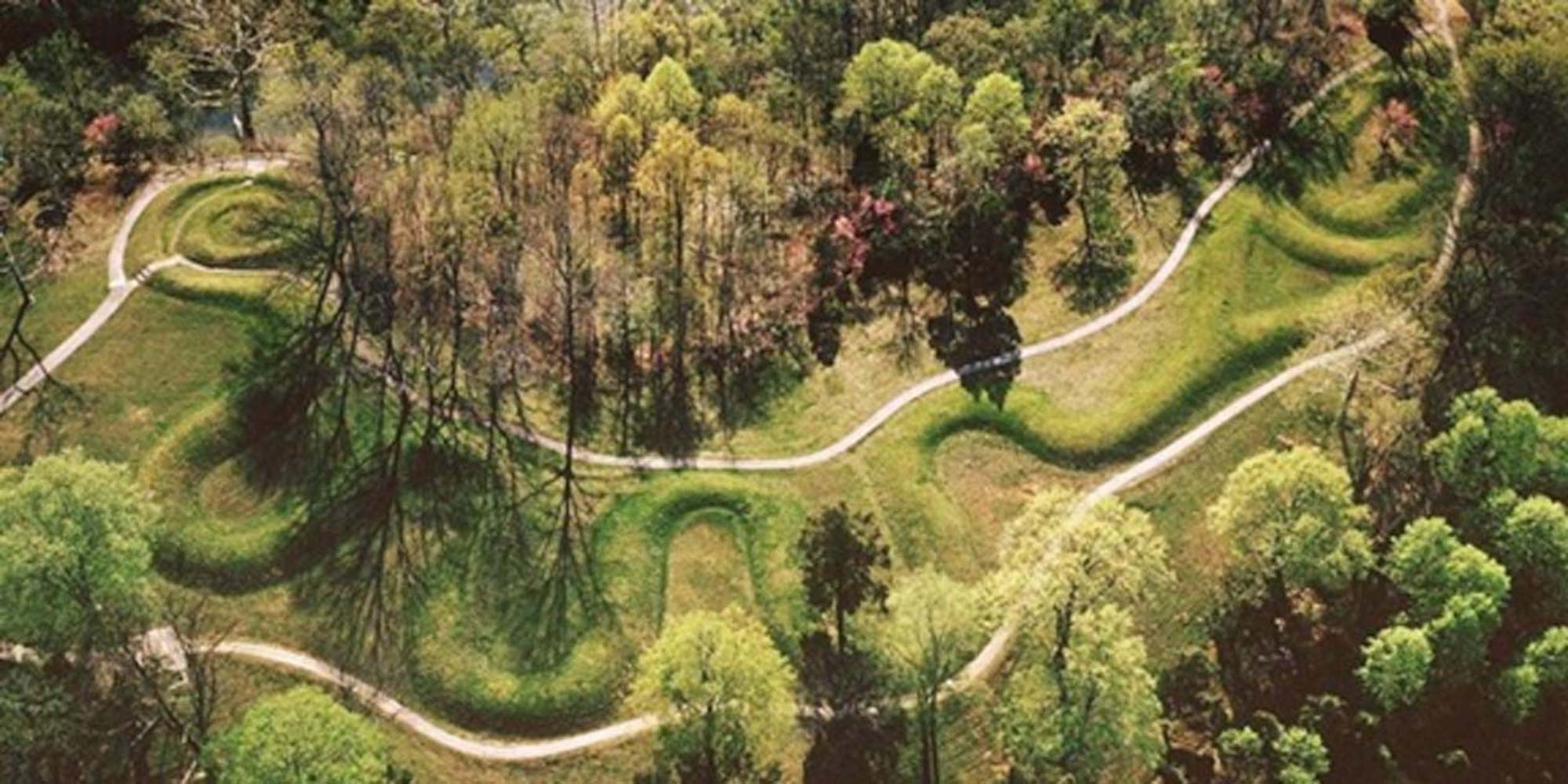
Ruler’s feather headdress (probably of Motecuhzoma II). Mexica (Aztec). 1428-1520 CE. Feathers (quetzal and cotinga) and gold. ADD MORE INFO
Context: could have been a gift from Moctezuma brought by Hernan Cortes to emperor Charles. People are unsure if it actually belonged to Moctezuma but it was found in a European inventory in 1596 acquired by Austrian Archduke Ferdinand II van Tyrol.
-Costume was very important to the Aztecs. However, the headdress is a static item. When worn, it completely transforms your appearance, but makes your identity less important than what you wear.
-Amanteca, feather workers, are very regarded (they make this)
Form: male quetzal feathers (each bird only has 2/3). This is found mainly all over in Central America, so tribute is being sent to Tenochtitlan as well. When the Aztecs conquer new peoples. they exact luxury goods like the feathers. Very iridescent
-pure gold ornaments, and other feather colors (turquoise)
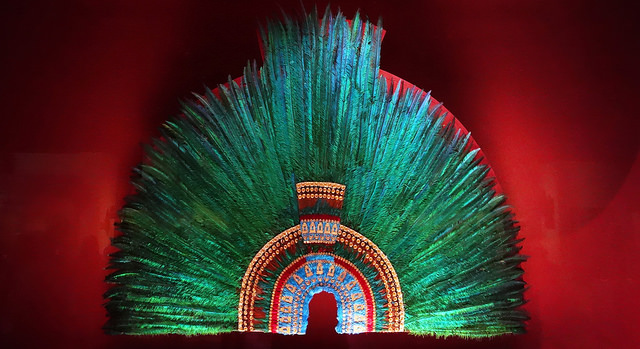
Angel with Arquebus, Asiel Timor Dei. Master of Calamarca (La Paz School). c. 17th century CE. Oil on canvas.
Form:
-Changes: oil on canvas and use of chiaroscuro: intense light and dark. Somewhat confrontational pose (symbol of conversion)
-Continuities: elongated, balloon-like sleeves are a symbol of Inka nobility
Function:
-Changes: Spanish missionaries sent it to promote Christianity and get rid of pre-Columbian traditions
-Continuities:
Context:
-Changes: Painted under the Spanish viceroyalty: administration of Spanish colonies. Made by Jose Lopez from Bolivia.
-Continuities:
Content:
-Changes: angels painted under the rule of the viceroy represent celestial, aristocratic, and military beings all at once. Carries a gun called an arquebus, made by the Spanish in the 15th century: fired by the shoulder (guns were seen as supernatural by the indigenous because they were unfamiliar). It represents the defense of Catholicism (violent methods used by colonizers)
-Continuities: indigenous clothing/features such as indigenous feathers.

Spaniard and Indian Produce a Mestizo. Attributed to Juan Rodriguez Juarez. c. 1715 CE. Oil on canvas.
Form:
-Changes: oil paint in European style=made for a European audience.
-Continuities:
Function:
-Changes:
-Continuities:
Content:
-Changes: Spanish man, Native American wife, and mestizo son carried on the back of a Native American servant. family is harmonious/well off=higher social status. Illustrates the ethnic mixing with Europeans, N. Americans, and Africans during colonization. Husband wears French clothing/powdered wig. Mother/servant look at the head of the family showing his importance
-Continuities: mother dressed in indigenous huipil garment
Context:
-Changes: Created by a Spaniard, Juan Rodriguez Juarez. Caste paintings modeled off of the Holy Family (St Joseph, Virgin Mary, and Child Christ). These paintings come in sets of 16: this is the first, and show more mixing as they proceed, becoming more racist towards the offspring and pureblooded Spaniards are dressed better to show superiority
-Casta paintings: created in colonial Mexico because Spaniards were concerned about other races gaining social status due to mixing with Spaniards. Some elites commissioned these paintings who were against the unions and made the mixed race people look poorer/rougher in poor conditions
-Commissioned by the Viceroy of New Spain who wanted to bring them to Spain. Purpose: want to portray mixed-race families as harmonious
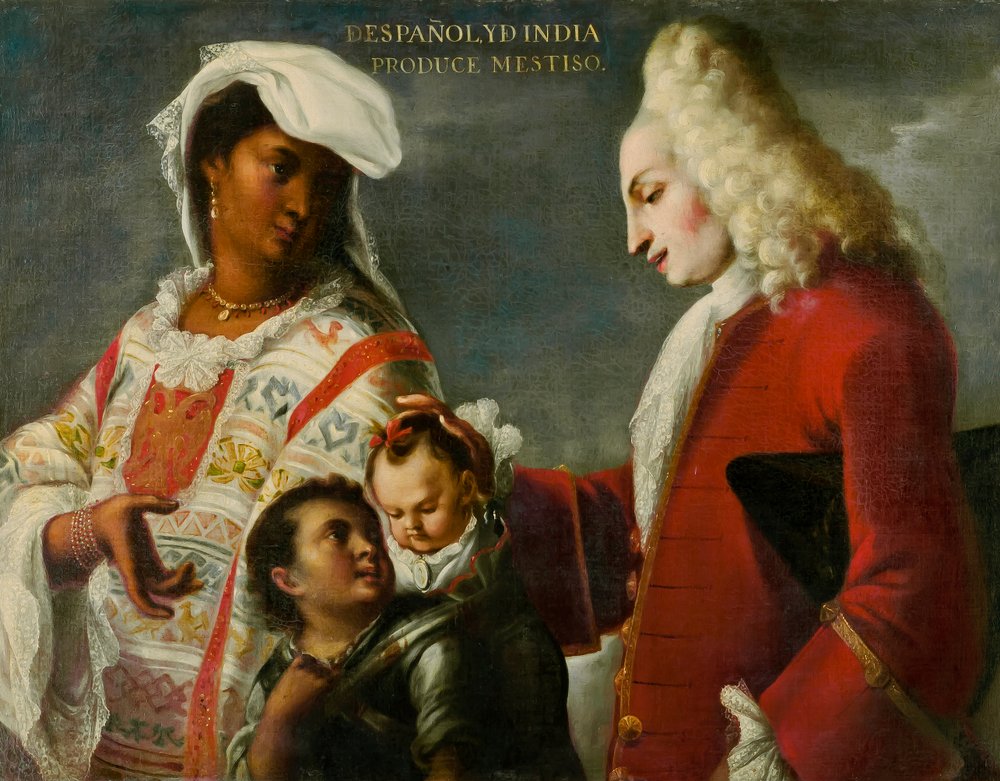
The Virgin of Guadalupe (Virgen de Guadalupe). Miguel Gonzalez. c. 1698 CE. Based on original Virgin of Guadalupe. Basilica of Guadalupe, Mexico City. 16th century CE. Oil on canvas on wood, inlaid with mother-of-pearl.
Content: She is the central figure, hierarchy of scale, crown.
-Changes: Virgin Mary from the Apocalypse from Book of Revelations (end of the world). She has stars around her cloak shrouded in the sun (mandorla) standing on the moon. Angel figures support the frames. Circles around her tell the story of Juan Diego’s vision in 1531
1. Mary speaks to Juan Diego in Nahuatl (Aztec) Continuity
2. She asks for a shrine on an old pagan hill
3. Bishop doesn’t believe him so she asks Juan to gather roses in a cloak and her image miraculously appears (acheiro poieta) ← common to icon paintings CHANGE
- Continuity: symbol of eagle on a cactus and Mary/Diego have darker native skin.
Context:
-Changes: Global trade is occurring from Spain, New Spain, and Japan. Intense catholic conversion of Natives. Vision occurs 10 yrs after Spanish conquest of the Aztecs.
Form:
-Changes: oil on canvas. The mother of pearl is shiny and reflects the light of heaven, making the image sacred
Function: shows national pride as Mary is the patron saint of Mexico city/New Spain
-Changes: Religious convergence justifies the conquest of Catholicism over native pagan sites (Hill of Tepeyac). Meant to be venerated (Catholic).

The Valley of Mexico from the Hillside of Santa Isabel (El Valle de México desde el Cerro de Santa Isabel). Jose María Velasco. 1882 CE. Oil on canvas.
Form:
-Changes:
-Continuities:
Function:
-Changes: Part of Lopez de Santa Anna’s effort to reestablish the art academy after its neglect when Mexico became independent. Creates national pride/identity of an independent nation with Romantic qualities
-Continuities:
Content:
-Changes:
-Continuities: Figures from the city wear indigenous garments but are located in the countryside: German subject called pastoral idylls which reflects the difficult socioeconomic relationship between people and their ancestral land (where poetic harmony and daily life unite) ← Change.
-Snowcapped volcanoes: Popocatepatl and Iztaceinuatl which are part of the preconquest mythology of 2 illfated Aztec lovers
Context: Romantic
-Velasco was interested in painting the local landscape accurately/descriptively to create a sense of pride in Mexico’s past, present, and future.
-Changes: Hill of Tepeyac: artist grew up here and the location where the Virgin of Guadalupe appeared to Juan Diego in 1531.
-Mexican independence after the Mexican war of Independence in 1821: industrialization effects: dust kicked up by machines in the background
-Velasco background: Academy of San Carlos was the first art school established in the Americas (Mexico City) modeled off an academy in Madrid was he studied the pure landscape concept by an Italian professor ← Change
-Continuities: Lake Texcoco: where Tenochtitlan was founded (to the right of it lies Mexico City where you can see the main cathedral)
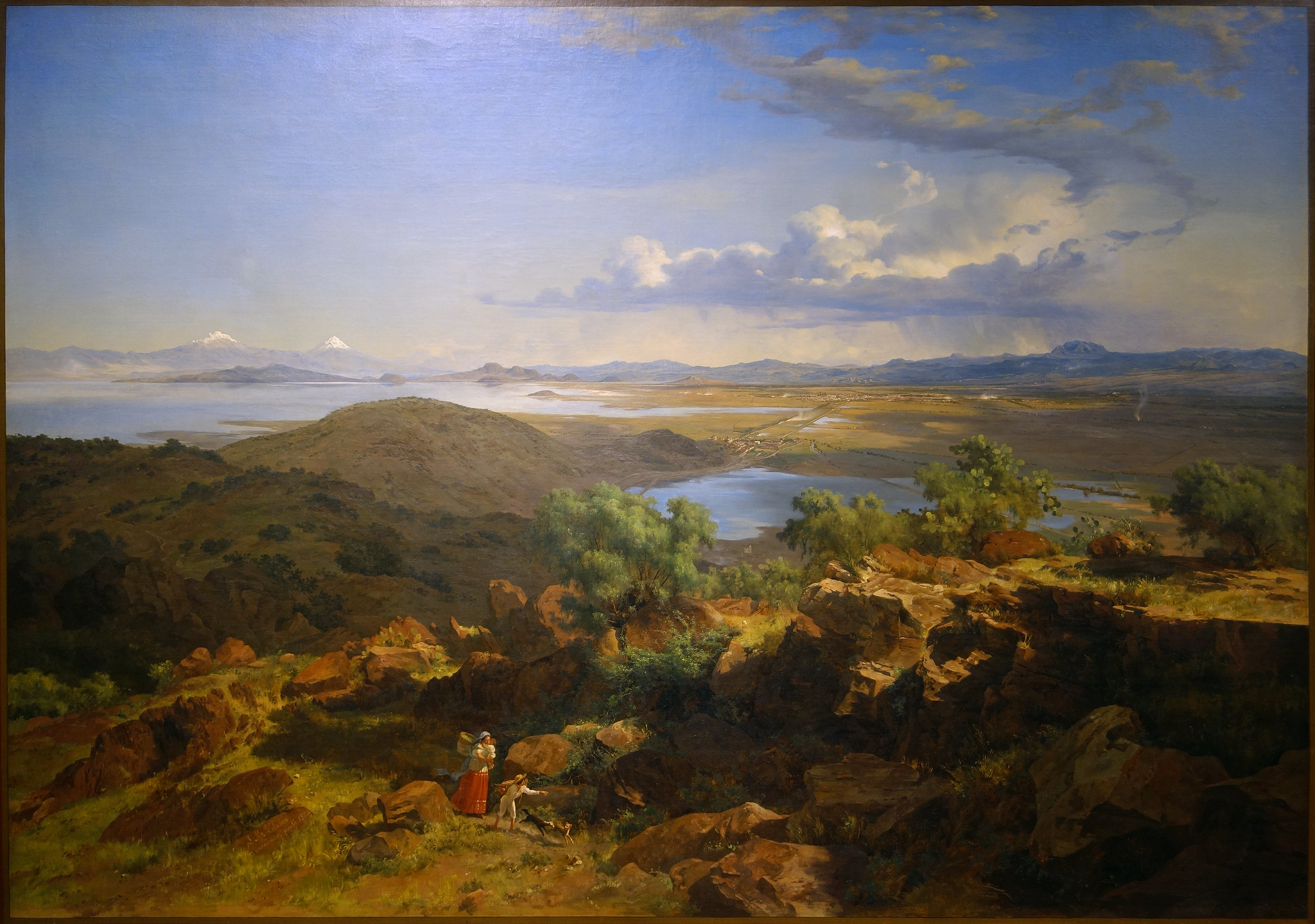
Portrait of Sor Juana Ines de la Cruz. Miguel Cabrera. c. 1750 CE. Oil on canvas.
Context: Sor Juana was born in the mid-17th century when Mexico was a Spanish colony for almost a century. She was born out of wedlock and raised by her mother. Her mother managed the estates of her grandfather despite the misogyny and her illiteracy. At a young age, Sor Juana mastered language/math/literature so she was invited to the Viceroy’s court. She wanted independence so remained unmarried and joined the Conservative Church. She wrote a lot on philosophy/mathematics and gained notoriety but because she was outspoken, many admonished her and she caught the attention of the Archbishop. She was stripped of her power and eventually resigned to the church but spoke out about topics related to women/men’s relationship, going against many ideas towards women at the time (Feminist).
-She was Creole (high-status but born in the Americas) Mexican and desperate for education at a young age, but the school was closed off to her when she followed her sister to school, encouraging her to become a nun
-She wanted to portray herself like a man would have in portraiture
-At the time, many women were either mothers, whores, or nuns.
Content:
-There are books in the back AND quills because she wrote a lot
-Confident body language, shoulders back, direct eye contact
-Rosary: indicates the status as a nun and function for prayers
-Nun’s badge: shows the annunciation where Mary is reading a book and the angel Gabriel descends from above
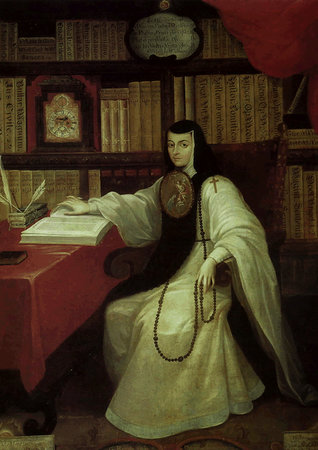
All-T’oqapu tunic. Inka. 1450-1540 CE. Camelid fiber and cotton. R
Context: Inka valued finely woven textiles because it was a cultural tradition and made in the idea environment: fishnets made from cotton, and good fibers available like camelid fur.
- Portable arts were much easier to manage than heavy breakable ones.
- Inka society valued collaboration that required help of all kinds of specialists like herders/sewers.
Form: over 360 wefts per inch with cobweb-like threads. Strung/carefully arranged to make a complex composition. Spinning/weaving work is excellent.
-Single-interlock tapestry: wefts wrap around each other when the color changes to make it look like one colors transforms to the next.
-A LOT of thread is used as an indication of power because it was unnecessary to the structure, but a valued commodity
Content: complex little squares filled with geometric motifs (toqapu).
-The darkest closer is a faded purple from indigo: high status color EVERYWHERE. It is hard to produce and from a mollusk of red/indigo dye. Involves the use of a lot of prestigious plants/animals only reserved for royalty
-Other colors give off power because there are so many=several dyes at the ruler’s disposal from many places. Inka used color as representative of status and made foreigners wear black=controlling
Painted elk hide. Attributed to Cotsiogo (Cadzi Cody), Eastern Shoshone, Wind River Reservation, Wyoming. c. 1890-1900 CE. Painted elk hide.
Form:
-Changes: portable size/decorative purpose. Commercial paints replace traditional ones.
-Continuities: Elk hide material
Function:
-Changes: sell to tourists and European-American collectors, reflecting the economic pressures of reservation life. Meant to be a romanticized description of traditional plains life catering for the nostalgia of outsiders. Shift from ceremonial → for commercial sale and a shift from traditional practices.
-Continuities: painted hides as a whole used to be for ceremonial/practical purposes such as sacred rituals/clothing/tipi decorations in the past
Content:
-Changes: Narrative art (European) and linearized appearance in an illustrative manner is made to appeal to outsiders. Horses are introduced by Spaniards
-Continuities: flat, dynamic figures and symbolic representations. Storytelling through bold, simplified imagery and traditional plains scenes like buffalo hunts and the Sun Dance (cultural practice)
-Tipis represent Shoshone’s village: warriors inside the tipis have eagle feathered headdresses showing bravery/honor.
-Buffalo head (near the middle)
Context:
-Changes: Shoshone Indians moved off to a reservation by the government and Native Traditions outlawed like the Sun dance
-Continuities: Great Basin/Plains relied on buffalo/elk for food/materials, which was readily available and culturally significant
-Sun Dance=renewal/resilience and thanking creator deity for Earth’s bounty
-Warrior exploits=bravery/communal identity
-Buffalo hunt: sustenance/spiritual connection. Hunted with arrows.
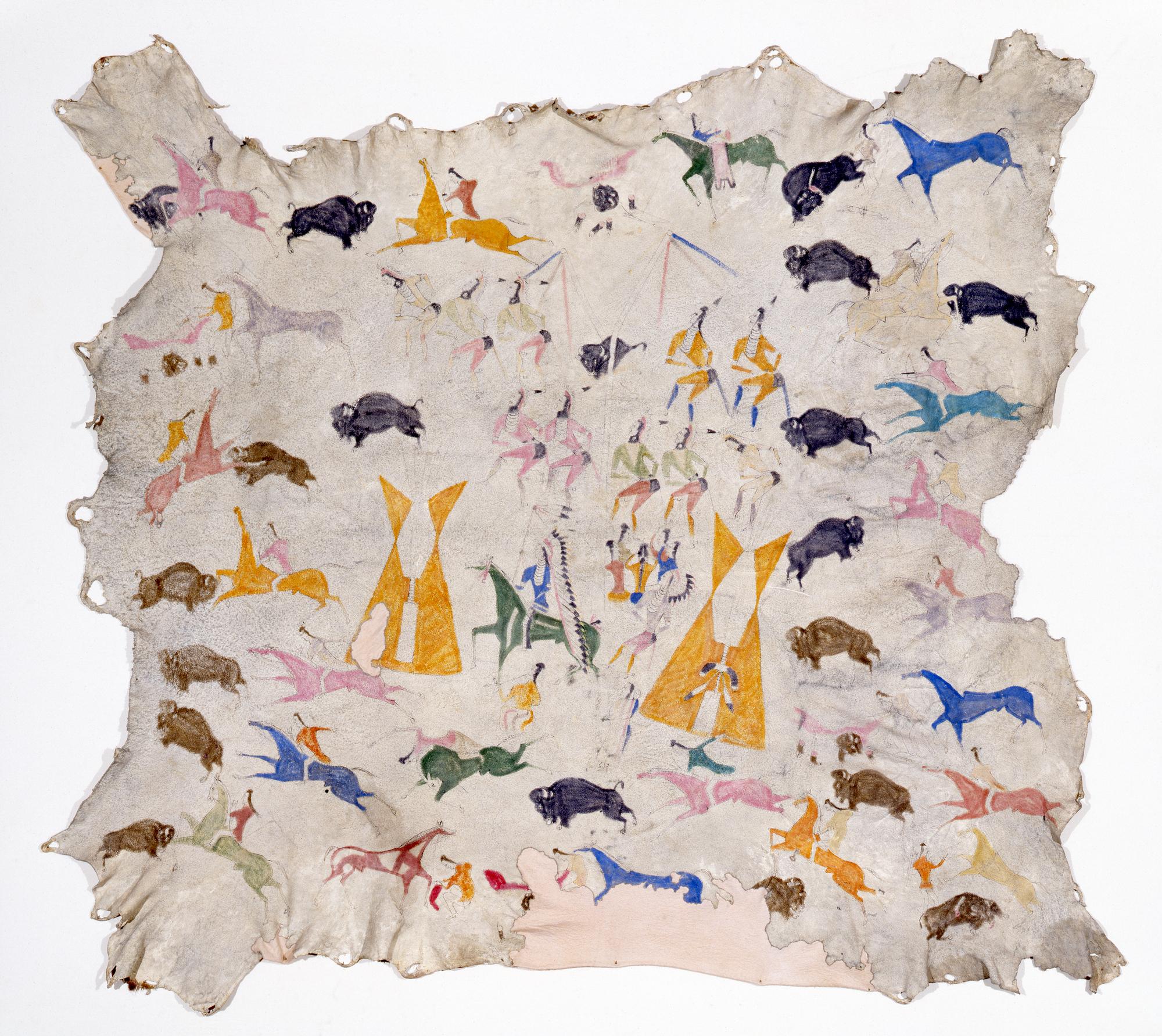
Frontispiece of the Codex Mendoza. Viceroyalty of New Spain. c. 1541-1542 CE. Ink and color on paper. R
Form:
-Changes: codex has 71 folios bound at the spine (European) translated to Spanish to better help Europeans understand the native art style/beliefs out of curiosity
-Continuities:
Function:
-Changes: gift to King Charles V (he never got it) and commissioned by the first Viceroy of New Spain (Don Antonio de Mendoza).
-Continuities:
Content:
-Changes: puff at the bottom represents 1521: Spanish took Tenochtitlan by siege.
underscores Europeans as the ultimate victors by placing the conquest of Mexico next to the Aztec conquests
-Continuities: features the founding of Tenochtitlan
Eagle on prickly pear cactus in center: sign from Huitzilopochtli for the Aztec to build their city
Ten founders of the city are conceptually presented in 4 parts separated by 4 lines representing canals
Aztec pictographic nouns/verbs, idealized geometric concentric organization
Bottom: story of conquest and the large square of settlement
Context:
-Changes: Patron: hired native artists and established them in workshops to make native artifacts, many which had been destroyed during conquest
-Continuities: Aztec founding myth
Yaxchilan. Chiapas, Mexico. Maya. 725 CE. Limestone (architectural complex). R
Content:
-Hieroglyphs: the date of Shield Jaguar II’s ascension to the throne
-vision of a two-headed serpent
Context: fasting/bloodletting can induce visions and allows supernatural ways to communicate with gods
-The one who has the vision has elaborate jewelry=wealth (Lady Xoc) who was the wife of Shield Jagauar II. She holds a basket with bloody paper: hole in tongue you put barbed wire through= pain attached to sacrifice
-used to be part of a group of lintels (running wire, vision, then telling her husband in hope the vision would help his military endeavors) City states often fought with each other.
-Found in a building above the 3 doorways
-Native Americans have respect for water/nature and the Maya are made of independent city-states
Form: structure 40 sits on an acropolis and is isolated (solitude). It has an astronomical function but is also a political propaganda artwork since the priest is the head of the buildings.
-structure 33 has a religious function because during the summer solstice, the sun strikes a sculpted figure inside. Fake fence and more centrally located/public
-Both: elevated platforms/3 doorway symmetry. The top part has statuary/a narrative.
Transformation mask. Kwakwaka-wakw, Northwest coast of Canada. Late 19th century CE. Wood, paint, and string.
Form:
-Continuities: large size to be dramatic. Wooden construction with traditional carving methods
formline art (undulating calligraphic line)/cedar= respect for the environment
Function:
-Continuities: central to Potlach gatherings: symbolizes life events, family/social status of the host, and spiritual connections to honor lineage/clan heritage
Content:
-Continuities: depicts animals like the raven/bear to represent key cultural myths
inner human face=transformation as supernatural forces embodied dancers wearing the mask
elaborate patterns/crest symbols with animal forms tied to specific clans
culturally significant colors: red=life, black=strength, blue=spirituality
sense of duality and bilaterally symmetrical
Context:
-Changes: Potlach banned in 1885-1951 by Canadian authorities to enforce assimilation
found to be immoral by missionaries: seized, placed in private collections (suppression) and stripped of ceremonial significance. Replicas sold as souvenirs for nonindigenous or appropriated in logo/fashion. Used as entertainment object/displayed in museums
-Continuities: reflects cultural, spiritual, and social values from oral traditions showing the connection between humans, animals, and spiritual realms
passed between family/clan (inherited/gifted)
Thunderbird: mythological ancestor of the people who could remove bird skin to assume a human form
complex visual storytelling

Screen with the Siege of Belgrade and hunting scene. Circle of the Gonzalez Family. c. 1697-1701 CE. Tempera and resin on wood, shell inlay.
Form:
-Changes: oil paint on wood and made with European techniques. Folding screen inspired by Japanese lacquer
Function:
-Changes: Made for the New Spain Viceroy Jose Sarmiento de Vallandes (controlled the silver mining industry/tobacco trade becoming very wealthy in Mexico) as a decoration in the Viceregal Palace in Mexico city. More secularized.
Content:
-Changes: The hunting reflects elite pursuits of leisure in the Spanish colonies
-Continuities: hunting scene is focused on nature/surroundings rather than the actual hunt. Native fauna/flora in hunting=connection to nature. ex: deer/wildcats
Context:
-Changes: Battle of Belgrade in 1668 (9 years before the piece was made): Habsburg were on defense who controlled the Spanish Empire/Central Europe defeated the Ottoman Empire (reflects European history)
Spanish, colonial, Flemish, and Dutch styles: Baroque/dramatic (emotionally intense)
luxury Asian goods arrived in new Spain, causing an increase in demand for expensive Japanese goods (made possible because of silver trade). The viceroyalty oversaw colonial administration, the economy, and spread of Christianity
-Continuities: made by indigenous man inspired by Asian culture (change somewhat)
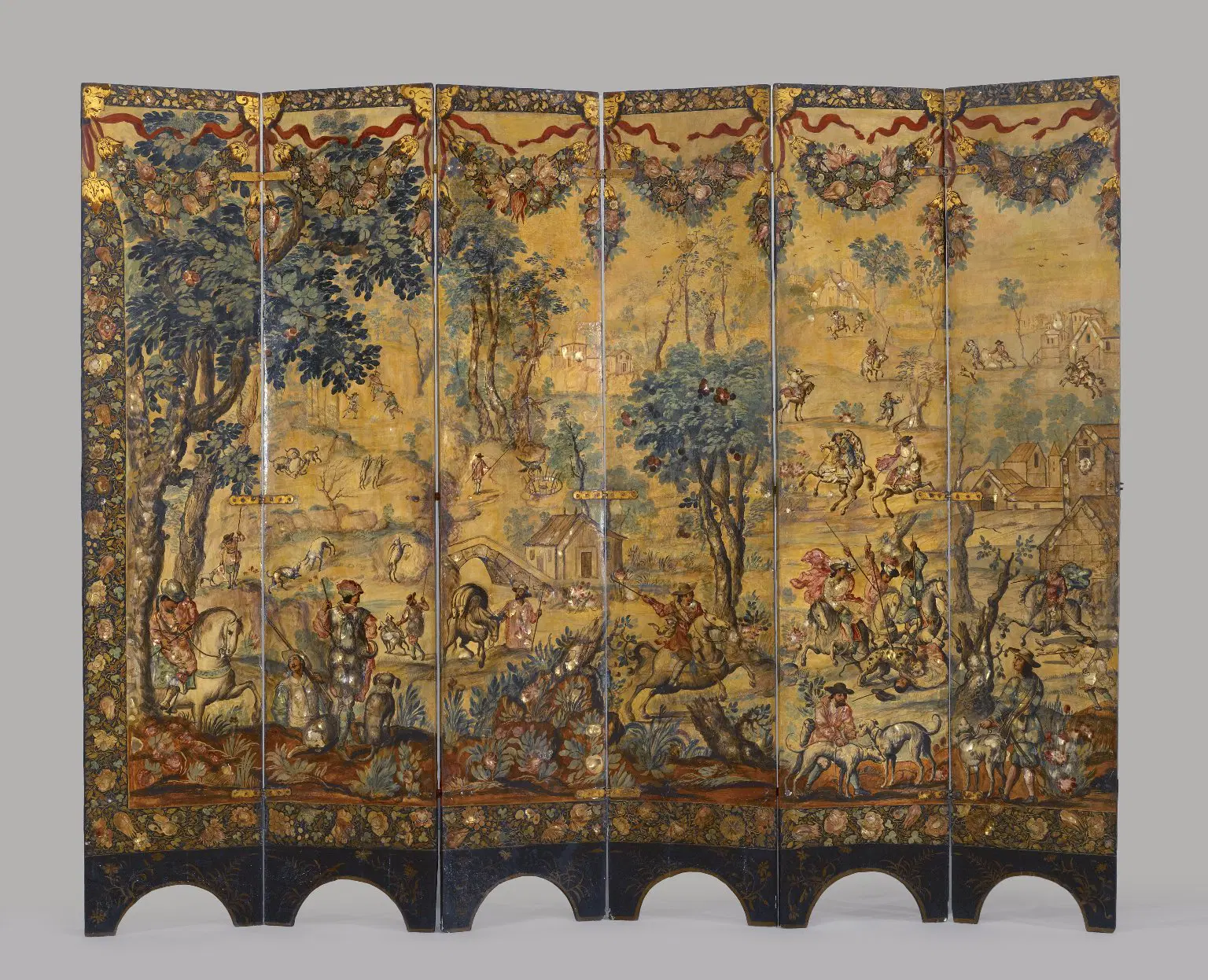
City of Cusco, including Qorikancha (Inka main temple), Santo Domingo (Spanish colonial convent), and Walls at Saqsa Waman (Sacsayhuaman). Central highlands, Peru. Inka. c. 1440 CE; convent added 1550-1650 CE. Andesite. R
Form: Qorikancha is a house group of gold and originally covered in gold. Kancha: group of rooms/buildings around a courtyard.
-each room is dedicated to a force (like thunder). 3 arched entryways, and a fortress like facade. Supported by Solomonic columns (spiraling shape introduced by Spanish) and Baroque architecture. Missionaries reoriented the temple when they realized its divinity for Christian purposes and placed a chapel at the back of the main church while the remains curve around the church’s foundation.
-No mortar used: Cyclopean masonry. Stones can individually move to withstand earthquakes (similar to Hagia Sophia)
-Construction: interlocking blocks/sloping walls made the building extremely resistant. In areas that were rainy, grass/reed roofs were made steeper and fixed with wood pegs.
trapezoidal walls make the walls seem thicker/higher
Tries to blend with the natural landscape
drainage canals/good ventilation because built on hillsides
Buildings, doors, and windows were placed to their best advantage visually wise so astronomical events could be witnessed like solstices
-Cusco’s layout: Puma because it was an important divine animal to the Inka. The main roads are at an angle and towns are in alignment with the central plaza, with royal residences facing sunrise.
Context: Spanish destroyed the temple to build a convent. The temple was originally higher-class (imperial) so it was larger with better stonework, and decorated lavishly with gold.
-Santo Domingo was built on top of the ruins of the conquered city and the remains of Qorikancha as a symbol of subjugation and Spanish power → triumph of Christianity over Paganism
-Conventos: large scale mission churches
Templo Mayor (Main Temple). Tenochtitlan (modern Mexico City, Mexico). Mexica (Aztec). 1375-1520 CE. Stone (temple); volcanic stone (The Coyolxauhqui Stone); jadeite (Olmec-style mask); basalt (Calendar Stone) R: get the colored image too
Stone Context: sacrifices were made the temple where bodies rolled from the top down onto the stone during a monthly festival called Panquetzalitztli (Raising of the Banners) to reenact the myth. Captives were killed at the top of Huitzilopochtli (god of warfare/sun) side.
-Huitzilopochtli’s mother Coatlicue was sleeping on top of the snake mountain, when feathers fell into her apron, impregnating her. Her daughter was told of this news and became very angry, rallying her brothers to kill the mother. Huitzilopochtli defends his mother and chops off the daughter’s bells, head, and throws her down the mountain
-Temple is symbolic of the mountain she was killed on
Olmec style mask Context: 1600-350 BCE. Best known for statues they carved (stone heads to commemorate rulers). They traded rubber in Mesoamerica as one of the first of these societies. Jade was traded inter regionally through trade routes.
-Deities: 8 different androgynous distinct ones usually representing natural elements like fish and rain. Elite rulers/shamans performed ceremonies with these in mind.
-Art: naturalistic OR highly stylized/anthropomorphic with religious iconography. Ex: cleft heads/downturned mouth
Form: not bigger than the palm of your hand, and polished.
Content: Olmec features: baby-like face, almond eyes, cleft in head. The Aztecs collected these to ritually bury as offerings showing reverence for ancient cultures.
Calendar Stone Context/Function: The Aztecs counted in 2 different ways: 260 day cycle used for purpose of divination (seeking knowledge from the future/unknown by supernatural means) which formed a sacred calendar or a 365 solar count (year count) which regulated the recurrent cycle of annual seasonal festivals. They act together as two rotating gears.